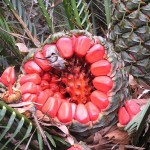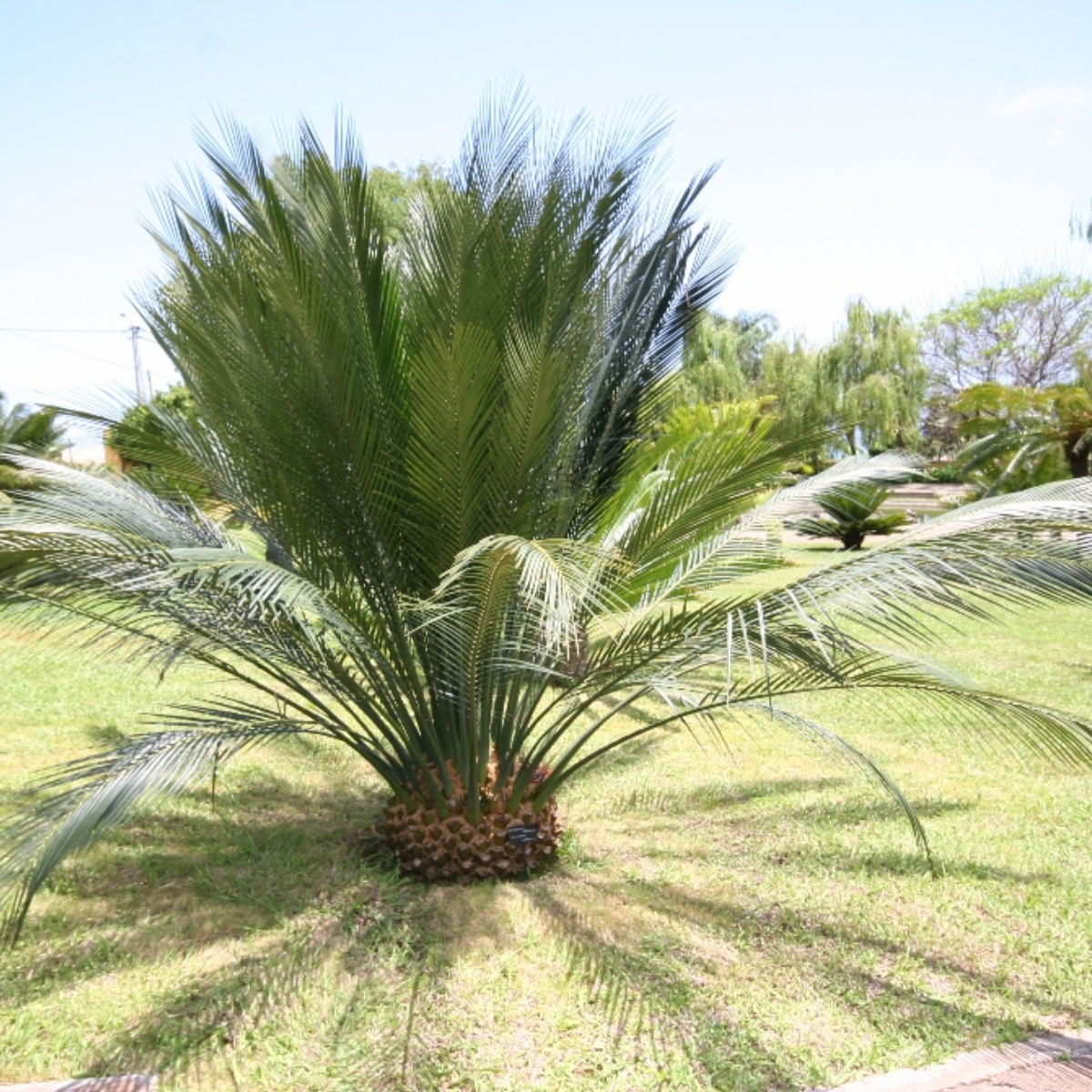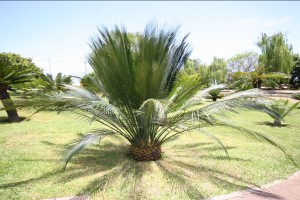Family: Zamiaceae
Distribution and habitat: Macrozamia communis is a cycad found on the east coast of Australia. Locally abundant in wet to dry sclerophyll forests, in coastal areas they grow in sandy soils and in nearby coastal ranges they grow in gravelly loams. It naturally grows in a temperate climate with warm to hot summers and cool to cold winters with frosts occurring in some areas. In its habitat it seems to prefer partially-shaded locations under an open Eucalyptus forest canopy.
Seed cones are formed after fire. Male and female seed cones are on separate plants and the large female seeds are ripe when red or yellow.
Description: Macrozamia communis is a palm-like shrub with long, gracefully arching, glossy green fronds (up to 50cm (20 inch) or more in a full grown specimen) with sharp, pointed leaflets in two regular rows, the lower few progressively reduced and rather spine-like. The mature female plant develops a number of large, football like cones about 25cm (10 inch) long. The male cones can measure up to 45cm (18 inch) with up to ten being borne per mature plant.
Macrozamia communisis a medium to large Cycad with a woody trunk up to 30-80cm (12-31 inch) in diameter and 0.3-2m (1-6.5 feet) tall. The trunk is typically underground, but may be emergent where growing on shallow soils or on rocky sites. The long fronds are arranged in a gracefully rounded crown arching out from the central trunk.
Houseplant care: Macrozamia communis are very slow-growing and potted specimens will grow to the portions of these in the open.
This plant has spines or sharp edges; use extreme caution when handling.
Light: Provide bright light for Macrozamia communis at all times. Well-estabilished plants are able to tolerate exposure to full sunlight.
Temperature: Normal room temperatures should be suitable, as long as plenty of fresh air is available. Standing the potted plants on trays of moist pebbles helps to maintain the right level of humidity. The ideal temperature range is about 10-27C (50-81F), though these plants can tolerate temperatures above and below this range without any apparent ill-effects.
Water: Water the plants liberally during hot weather, 27C (81F) or over. At other times, water moderately, enough to keep the potting mixture moist, but do not wet.
It is also a good idea to mist-spray the foliage occasionally.
Fertilising: Apply a dressing of complete fertiliser fortnightly during the growing season.
Potting and repotting: Use a soil-based potting mix. Place some broken pot pieces or other drainage material in the bottom of the pot to ensure adequate drainage.
As these plants are such slow growers they seldom need repotting. If necessary, repot in late spring.
Propagation: Propagation is normally by seed (germination will occur in 6-24 months) or from recently germinated seedlings gathered from beneath female plants. Early seedling growth is very slow. The amateur gardeners is best advised, however, to avoid this lengthy procedure and buy an established young plant.
Problems:
Mealybugs are the only major insect pest affecting Macrozamia communis.
Treatment: This can be easily controlled by the application of insecticide about twice during the growing season.
Scale insects may occasionally infest the crown.
Treatment: Apply adequate insecticide about twice during the growing season.
Toxicity: All parts of Macrozamia communis plant are poisonous if ingested.
Notes: Macrozamia means literally 'large Zamia', Zamia being a tropical genus containing some of the Cycads earliest defined their by botanists. Cycad is a term used for a group of plants which, despite their appearance, are actually more closely related with conifers. They are believed to be geologically ancient, with a fossil record going back more than 150 million years. Like conifers, they bear their seeds on scales arranged in large cones (Cycas is an exception as its scales do not form a proper cone) and all Cycads have their pollen bearing scales arranged in cones. They are dioecious - that is, there are separate male and female plants - and cones of both sexes can be extremely large (up to 80cm (31 inch) long in some cases).
Macrozamia communis is fire-retardant.
Uses: Macrozamia communis make a very decorative container plants for indoors - if the position is very airy and well lit - or for verandahs and patios.
It is drought-tolerant and it is suitable for xeriscaping.
SUMMARY:
CHARACTERISTICS:
Foliage green
Shape upright
Height: 1.8-2.4m (6-8 feet)
PROPER CARE:
Watering in rest period sparingly
Watering in active growth period moderately
Light bright filtered
Temperature in rest period min 10C max 21C (50-70F)
Temperature in active growth period min 18C max 27C (64-81F)
Humidity high
Hardiness zone: 8b-11





